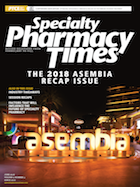Goal-Directed Therapy Can Improve Outcomes in Pulmonary Arterial Hypertension
Specialty pharmacies play a crucial role in providing the complex treatment regimens needed to treat pulmonary arterial hypertension (PAH), a rare life-threatening disease that requires specialist care.
Specialty pharmacies play a crucial role in providing the complex treatment regimens needed to treat pulmonary arterial hypertension (PAH), a rare life-threatening disease that requires specialist care.
This 2-part symposium presented on the opening day of the Asembia Specialty Pharmacy Summit 2018 provided attendees with a comprehensive approach to specialty pharmacist management of PAH.
In the first presentation, Amy Dzierba, PharmD, BCPS, FCCM, provided a disease overview of PAH followed by an in-depth discussion of drug therapy. To lay the foundation for understanding this complex disease, she explained key concepts in lung physiology. Understanding the role of prostacyclin, nitrous oxide, and endothelin pathways in PAH pathophysiology is crucial because these pathways are targets for PAH drug therapy. She outlined the clinical classifications of pulmonary hypertension and their etiology, including the role of drugs such as “fen phen.”
Attendees gained insight into why diagnostic delays are so common after hearing about the vague symptoms seen in the early stages of PAH and the complexities of diagnosis. The overview culminated with an examination of treatment. Algorithms help define the role of calcium channel blockers and supportive measures such as oxygen, diuretics, digoxin, and warfarin. She then explored targeted treatment options for PAH, including prostacyclin analogs, endothe- lin receptor antagonists, phosphodiesterase-5 inhibitors, and the soluble guanylate cyclase stimulator, riociguat (Adempas). Dzierba examined the drugs in each class, and their roles, and considerations for use, such as adverse effects, drug interactions, route of administration, and stability issues.
The second part of the symposium focused on the role of specialty pharmacists in caring for patients with PAH. The cost of drug therapy for PAH often exceeds $100,000 each year. Christopher Ogurchak, PharmD, MSPBA, CSP, began his presentation by pointing out the vital role that specialty pharmacy providers play in navigating prior authorizations and co-pay assistance and investigating foundational support. He reviewed access for drugs that treat PAH, providing details for each drug, including distribution (open vs limited), specific network pharmacy providers for limited-distribution drugs, Risk Evaluation and Mitigation Strategies (REMS) requirements, hub support, and co-pay assistance.
Some PAH drugs have REMS programs, most of which are intended to prevent pregnancy in women receiving teratogenic drugs. Ogurchak focused on the role of specialty pharmacists in helping prescribers and patients comply with REMS requirements, including program enrollment and laboratory testing requirements. He outlined the steps required for outpatient pharmacies to obtain REMS certification and conform to regulatory requirements. The presentation ended with clinical pearls about one of the most important services specialty pharmacists provide to patients with PAH—patient education, counseling. Tips included administration, adverse effects, and drug interactions for PAH drugs.

